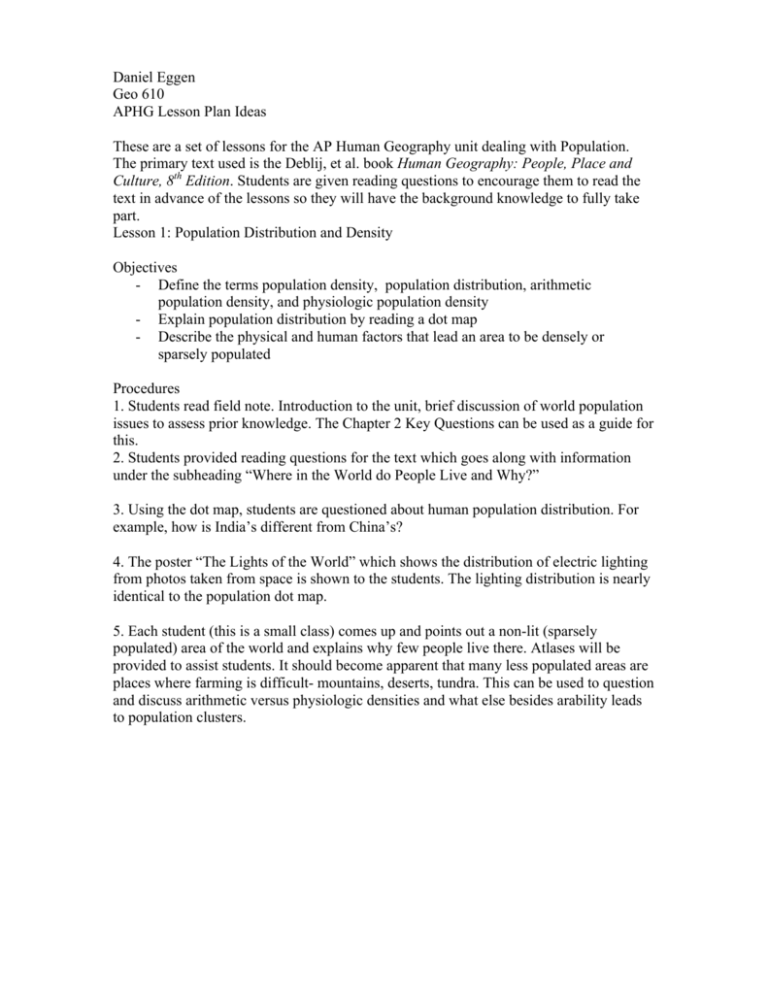Population - CAS Courses
advertisement

Daniel Eggen Geo 610 APHG Lesson Plan Ideas These are a set of lessons for the AP Human Geography unit dealing with Population. The primary text used is the Deblij, et al. book Human Geography: People, Place and Culture, 8th Edition. Students are given reading questions to encourage them to read the text in advance of the lessons so they will have the background knowledge to fully take part. Lesson 1: Population Distribution and Density Objectives - Define the terms population density, population distribution, arithmetic population density, and physiologic population density - Explain population distribution by reading a dot map - Describe the physical and human factors that lead an area to be densely or sparsely populated Procedures 1. Students read field note. Introduction to the unit, brief discussion of world population issues to assess prior knowledge. The Chapter 2 Key Questions can be used as a guide for this. 2. Students provided reading questions for the text which goes along with information under the subheading “Where in the World do People Live and Why?” 3. Using the dot map, students are questioned about human population distribution. For example, how is India’s different from China’s? 4. The poster “The Lights of the World” which shows the distribution of electric lighting from photos taken from space is shown to the students. The lighting distribution is nearly identical to the population dot map. 5. Each student (this is a small class) comes up and points out a non-lit (sparsely populated) area of the world and explains why few people live there. Atlases will be provided to assist students. It should become apparent that many less populated areas are places where farming is difficult- mountains, deserts, tundra. This can be used to question and discuss arithmetic versus physiologic densities and what else besides arability leads to population clusters. Lesson 2: Population Changes- The DTM Objectives - Students should be able to define relevant terms such as doubling time, replacement rate, total fertility rate, crude birth rate, crude death rate - Student should be able to explain how and why how birth and death change as areas develop economically using the demographic transition model as a guide. This should also be linked with being able to explain the current population explosion Procedures: 1. Students read and answer reading questions for the subheading “Why do Populations Rise and Fall in Particular Places?” 2. The basic shape of the DTM is drawn on the board and the teacher asks a student what it is. The student may or may not know. It can be an amusing introduction if the student actually doesn’t know and has to guess or the teacher makes up a story about what these two colored lies on the board are. Eventually, it should be explained that this is the DTM which shows changes to population as places grow more developed. 3. Each stage is the n looked at as follows; - A boy and girl are picked to come up and be a married couple whose family structure will change as the go through the stages of the DTM. For each stage, the couple can stay the same or be changed depending on class size. The “children” are reset each time, the couple string out each stage with none. It should be explained that this would show differences in as a single place develops or as you go from place to another in different stages of development. Stage 1 - 8 other students are then called to come up and represent the children the couple had. 6 of these “are killed off” (told to sit back down). Reasons for their deaths are explained including: One gets bacterial illness from bad drinking water and dies of diarrhea at six months old One dies of malnourishment from a protein deficiency at age 4 One is badly cut from a fall and dies from the resulting infection at age 12 One is married young and does in childbirth at age 16 One goes off to war and is killed at age 17 - In the end only two live and the ides of replacement rate is explained- the population has stayed essentially the same despite the large number of children the couple had. Stage 2 - Again 8 children are born. This is a good point discuss the reasons why people in stages one and two want so many children. - This time only 2 students are killed off. For a few others it can be explained how something could have killed them, but they survived. For example, an illness is treated with antibiotics, or no one dies young as now they have clean drinking water. - This fact that this couple is now triple their replacement level should clearly demonstrate why the developing world is experiencing a population explosion Stage 3 - Now only 4 children are born and only one dies. Reasons why people want fewer children can be discussed Stage 4 -Now 2 children are born and both live. Reasons why are discussed along with the fact that population is now once again at an equilibrium replacement level. Stage 5? - The teacher could choose to include the possibility of stage 5 or not. If so, one child could be born that lived. This may not be the best to do as it exaggerates the drop in the birth level and the resulting possible population decline. Instead the teacher may just explain the idea of stage 5 and some of the example countries such as Japan and Italy 4. After this activity, the teacher asks follow up questions of various students to assess if the point of the activity was fully understood. Lesson 3 – Population Composition and Population Momentum Objectives: - Students will be able to define the terms population composition, population pyramids, infant mortality rate, child mortality rate, life expectancy, and chronic diseases - Students will be able to decipher attributes of a population based on their population pyramids - Students will be able to recognize the effects of demographic momentum based on several population scenarios Procedures: 1. Students will read and answer reading questions for subsection titled “Why does Population composition matter?” 2. In the computer lab students will carry out the Activity 5.1 from Kuby’s Human Geography in Action website, “Matching Demographic Descriptions with Population Pyramids”. On questions sheet they will answer and sketch the basic shape of the population pyramid. The teacher needs to go around and ask students about some of their choices to assure they are not just guessing until they find the right answer. 3. Students will then carry out Activity 5.2 from HGIA site, “Demographic Momentum”. This activity could prove a bit confusing at first, so the teacher needs to explain beforehand what the different graphs show and how to use the scenario effectively. 4. Students will turn in their answers for activity 5.2 to be grades based on accuracy and depth of explanations.





